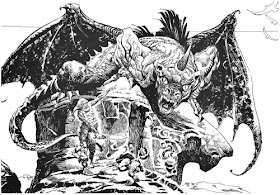 |
| It had a baby! |
The hit/to-hit/class die: If you are rolling to attack or do something that fits the idiom of your class/race/background, you may add your hit die onto that roll. Roll to meet or beat an AC or DC. The DCs are 5, 10, 15, 20, 25, 30, and so on (don't use DCC thief DCs).
Armor: Armor Class is your Agility score. Armor itself is ablative; for each plus it has, it can take one hit instead of you, negating one instance of damage. This damages the armor and it has to be mended. Shields usually give +1 armor.
Damage: Arms* are flavor, for the most part, and don't affect damage. Maybe your implement of choice is important in some situations. Your HD from the to-hit roll is also counted--provided you hit-- as your damage roll.
Example: Thogar rolls to hit. His STR is 8 and his class is thief, so he rolls 1d20+1d6. He gets a 19 and a 2, for a total of 21 to hit. The 2 becomes 2 damage. The player shakes the Judge's hand for running such a fast system, but then they both get Coronavirus.
Luck: You can burn Luck or Fleeting Luck to modify rolls up or down in your favor (you can spend Luck on someone else's roll to avoid being hit). Fleeting Luck follows the DCC L rules.
Spell-burning: Wizards can grow their hit die for one instance of casting. It grows one size for each point of ability score damage you take. Spell-burning is ritualistic, so it slows you down and your friends will have to be meat shields while you get it ready. If you know Lankhmareese black or white magic, the first point of spell-burn on those spells is free, but you have to burn more than one.
Magic: You have to roll to learn a spell (fail and you can try again next level). Lvl 1 spells are DC 10, lvl 2 are DC 15, and so on. So you might want to quest for a specific way to learn a specific spell at a lower DC (Lankhmar agent dice might work out too). When you first learn a spell, you have to roll on this table of quirks (no mercurial magic).
Initiative: If you roll higher to hit, you hit first. Most monsters are zaku (small fries). If you hit, you kill them and hit first and they don't get a counter hit. You're no hero, but you might be fit for a pulpy tale.
Deeds: Unlike in DCC where they have to wait for a precious 3+, Warriors in this house may declare a mighty deed each time they hit (don't declare, then roll; roll first) except when they roll a crit, in which case the crit becomes the deed. Tough monsters may get a save to resist the effects of a deed, in which case their DC is 10+the Warrior's level.
Get Gud: Every PC stops gaining HD after level 3, instead re-rolling all previous hit dice and taking the new score if it is higher. Thank you, Dave "Arduin" Hargrave. Another benefit of leveling is that you get to choose one ability score and raise it by 1.
Orizons, not spells: If we had clerics in DCC L, they would not have set spells, but would just beg their gods for help with a prayer roll. What a pointless bullet point this was though.
Star signs: On worlds that use them, we look at what the sign usually affects and give +1d to action dice involving that. No negative star signs, and Luck doesn't make it better or worse to have.
*: I might find a way to integrate arms into the crit tables in the future.
----
Share good posts with good goblins. Claytonian at the gmails.


No comments:
Post a Comment